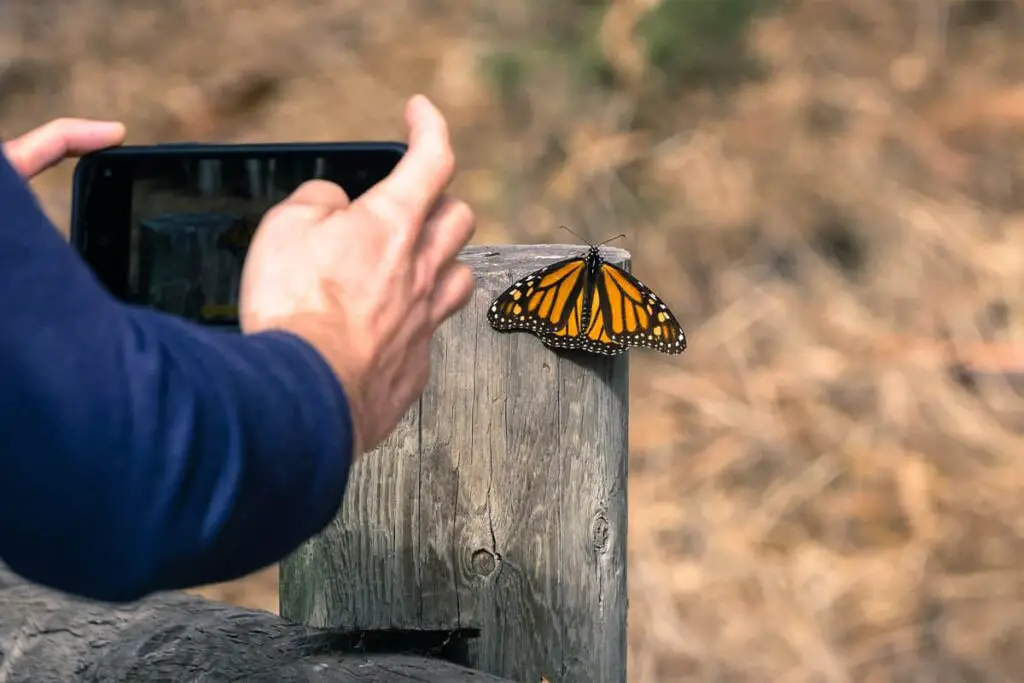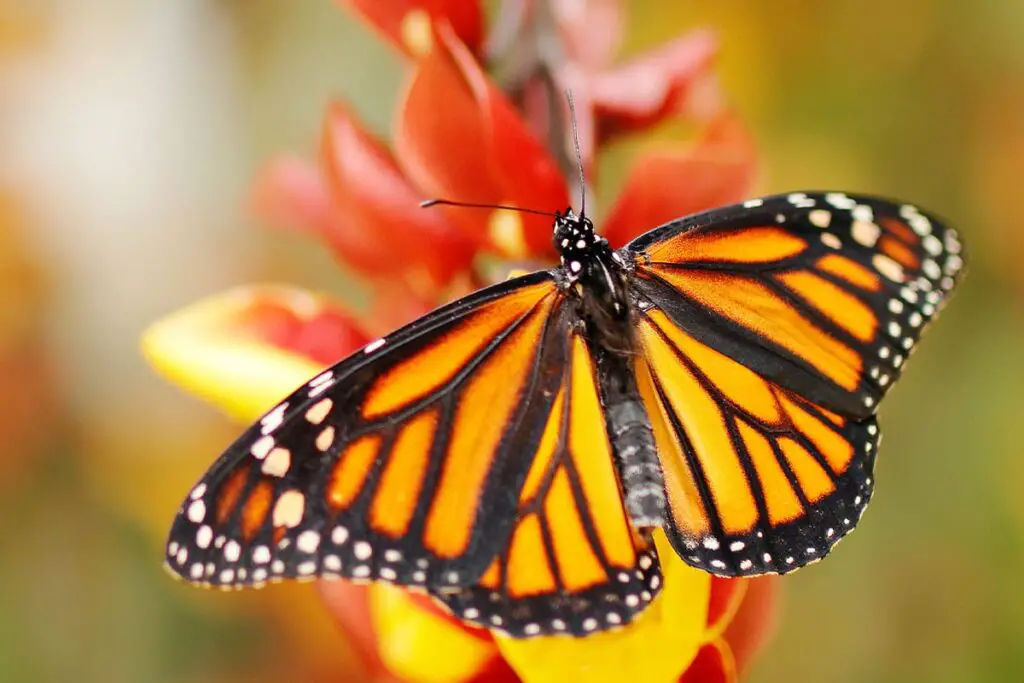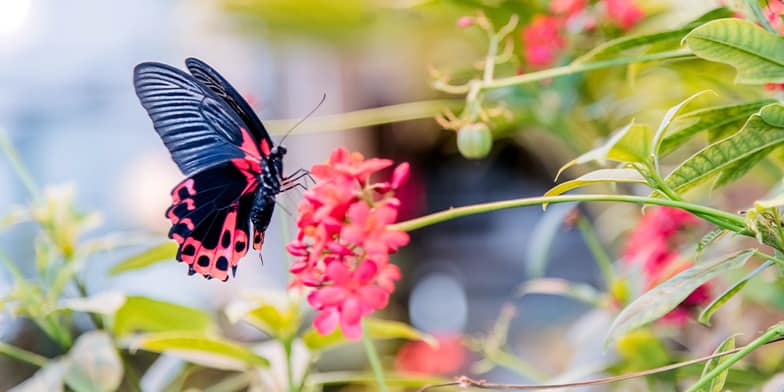
Butterflies are small, gorgeous little creatures. They appear to lead these unassuming short-lived lives, but much to the surprise of many, a butterfly is constantly up to something! Even though they seem so carefree, their search for food is an ongoing struggle. But what do butterflies eat, and how often?
Butterflies eat every day if they can. A butterfly is constantly searching for food or nutrients, most commonly in the form of nectar but also from rotting fruit, mud puddles, and trees. However, a butterfly can go some time without eating if there isn’t an available food source.
A butterfly has quite a lot to accomplish in its short life span, from eating to finding a mate and reproducing. Read on to learn all about a butterfly’s eating habits, as well as maybe learn a thing or two about how to attract more butterflies to your garden!
How Often Do Butterflies Eat?
A butterfly is constantly searching for food. They will seek out nourishment on a daily basis from flowers, as well as various other sources.
Butterflies need this nourishment to stay alive so that they may find a mate and reproduce. Additionally, the constant search for food ensures that the butterflies always have enough energy to fly. If they do not eat often, they will become lethargic and will have difficulty getting off the ground.
While butterflies are not as good of a pollinator as bees, this flying from flower to flower every day does make the butterfly an important part of the pollinating system.
What Time of Day Will a Butterfly Eat?
Butterflies seek out food constantly; however, there is an ideal time and place for this activity.
Butterflies are cold-blooded creatures. This means that a butterfly cannot start the day with food because it will then be too cold and sluggish to fly.
Therefore, a butterfly will wait until the sun rises and spread its wings to increase its surface area and absorb the maximum amount of sunlight. This basking usually takes place just after the sun has risen and is necessary before a butterfly can search for food.
Once a butterfly has basked and increased its body temperature enough, it can fly off. However, butterflies are most active in the afternoons and will therefore do most of their food searching during this time.
What Do Butterflies Eat?
Butterflies are commonly known to drink nectar from flowers.
Nectar is basically sugar water that gives butterflies energy. Aside from this, there are other vital nutrients in nectar, such as vitamins, proteins, and amino acids.
Nectar is the most sought out food source for a butterfly, but they do have many other options.
Butterflies also eat from:
- Mud puddles
- Rotting Fruit
- Trees
- Animal dung
- Anything salty!
Although we humans would never drink from a mud puddle, it isn’t uncommon to find a group of butterflies drinking from the murky, muddy water. This is called puddling. Mud puddles are full of minerals that are essential for nutrition.
Another thing we wouldn’t eat is rotting fruit – but butterflies love it! As you probably know, rotting fruit is very squishy and soft. This tenderness makes it very easy for butterflies to suck all of that juiciness out.
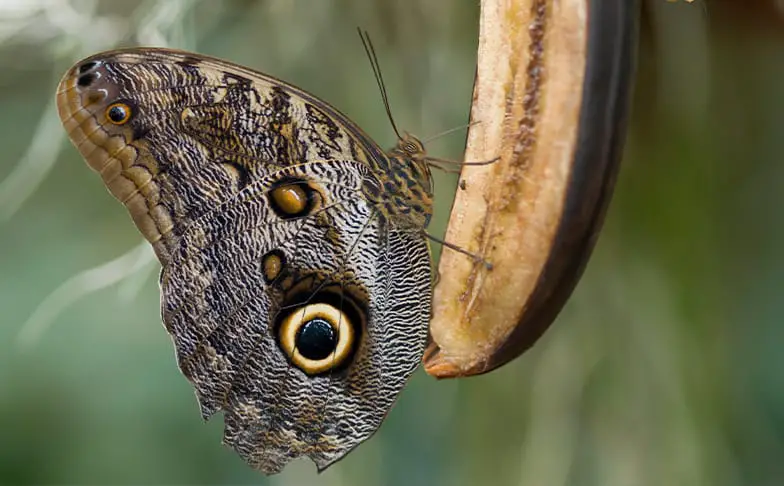
Animal dung is a great source of nutrients and minerals for a butterfly.
Tree sap, however, is not a favorite of the butterfly and is more of a last resort. It can be eaten, but is not common.
Have you ever noticed a butterfly landing on your arm? Well, interestingly, butterflies love anything salty because of the sodium. It isn’t uncommon for a butterfly to smell the presence of salt on our arms (especially sweaty arms) and come flying towards it for sustenance!
How Do Butterflies Eat?
Butterflies have quite an interesting way of sourcing food and eating.
How Do Butterflies Eat: The Antennae and the Feet
Before a butterfly can begin to eat, it has to find the food first. Funny enough, butterflies do not only rely on sight but also use their antennae and feet to decide if something is edible.
A butterfly’s antennae are used for scent. The butterfly can identify smells in the air using its antennae. Using their senses combined, they will move towards a food source such as a flower.
Fascinatingly, once at a flower the butterfly will use its feet to test its food! The butterfly has taste receptors located underneath its feet, which they use to decide if something is tasty or not.
How Do Butterflies Eat: The Proboscis
Now that the butterfly has seen and tasted the food, it needs to get busy eating.
Butterflies have what is called a proboscis. If you’ve ever looked closely at a butterfly, you will notice a black coiled up tube – that is the proboscis.
When a butterfly has found a desired food source, the proboscis will uncoil and pierce deep into its food source until it reaches liquid. Once uncoiled, the butterfly can suck out all the juicy goodness.
Flowers That Attract Butterflies
Butterflies love nectar, and they will try to find it wherever they can. If you’re looking to attract more butterflies to your garden, you might ask yourself which flowers are their favorite.
Here are 10 flowers that are sure to attract butterflies:
- Butterfly Bush: This shrub’s gorgeous coloring is the main attraction for butterflies.
- Sunflowers: Sunflowers are large and colorful but are also full of nectar.
- Cornflower: This flower has bright colors to attract butterflies.
- Marigolds: This colorful flower attracts both butterflies and bees!
- Buttonbush: This flower is ideal for butterflies as it has a large surface area, so butterflies can rest upon it while they eat.
- Lavender: This flower is loved by butterflies for the silver leaves and purple flowers!
- Daylily: The daylily has large orange flowers and sweet nectar easily accessible for butterflies because of its tubular shape!
- Phlox: The Phlox comes in all sorts of colors which are sure to attract butterflies.
- Clove Pink: This plant boasts all sorts of colors that butterflies love.
- Salvia: Salvia is known to attract not only butterflies but hummingbirds too due to its coloring and delicious nectar.
Be sure to add any (if not all) of these beautiful flowers to your garden, and you will see many more butterflies floating around.
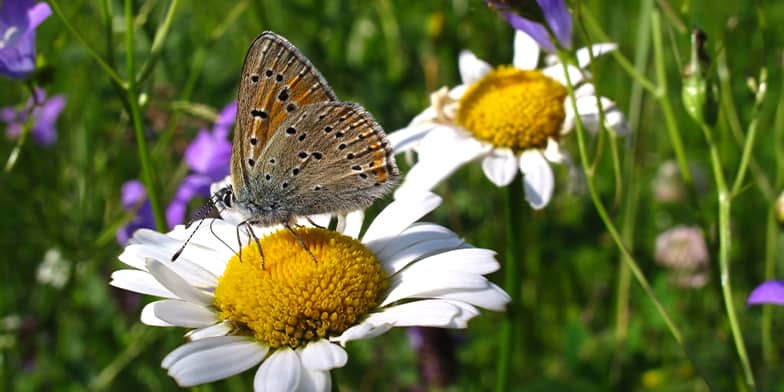
How To Make A Butterfly Jar Feeder
Now that you know about all the flowers that can attract butterflies, there is one more thing you can place in your garden that will keep butterflies coming back for more.
There are many things that can be turned into a butterfly feeder; however, the ideal and easiest one is a butterfly jar feeder. This can be made in 6 simple steps.
Making A Butterfly Jar Feeder: Step 1
The first step to making a butterfly feeder is finding a jar of any size and making a hole in the lid. You can use a hammer and a medium to thick nail to pierce the jar lid. Watch those thumbs!
Making A Butterfly Jar Feeder: Step 2
After you’ve made a hole in the jar lid, it is time to find a sponge. Make sure you are using a fresh sponge that has not been used before; otherwise, any bacteria left in the sponge could harm the butterflies.
Cut a half an inch long strip off the sponge. After you’ve done this, you can push this sponge through the hole so that half remains inside the jar and half remains outside.
This sponge is going to allow butterflies to drink the juicy goodness from inside the jar.
Making A Butterfly Jar Feeder: Step 3
After the sponge is secured, it’s time to decorate the jar and make it as brightly colored as possible. As you’ve seen, butterflies are attracted to bright, colorful flowers that catch their eye.
Take the time to decorate your jar so that it’s bright enough to entice a butterfly to land on it. Be creative!
Making A Butterfly Jar Feeder: Step 4
Once the jar is decorated, you need to fill your jar with some juicy nectar for the butterflies. Remember, nectar is practically sweet water.
You can make two types of nectar for your butterflies.
- Sugar water nectar
- Honey water nectar
It doesn’t matter which you decide to do – the method remains the same. In a pot, add one part sugar (or one part honey) and four parts water. Let this boil, and then stir it until everything is dissolved.
Tip: Please stay away from dying your butterfly mixture with any colorant. There are certain aspects of dye that may be harmful to butterflies, so please avoid this. If your jar is colorful enough, then that should be all you need.
Making A Butterfly Jar Feeder: Step 5
While your nectar is cooling, it’s time to tie your jar so that it hangs upside down – allowing the nectar to seep into the sponge.
You can start by tying a piece of string around the neck of the jar. You can make this quite tight.
Now cut two separate pieces of string, around 2-feet long each. Once you’ve done this, tie one of these pieces around the string on the jar neck. Directly opposite the first piece, tie the other string so that the jar hangs balanced upside down when you hold these two strings.
Making A Butterfly Jar Feeder: Step 6
Once your jar is nicely balanced, you can open the jar and pour in the cold nectar. Tighten the lid with the sponge and test to see if any liquid drips out. It’s important that the sponge fits snug so that the nectar isn’t constantly dripping.
If it isn’t dripping, then your butterfly feeder is ready to be tied up in your garden. Take the two strings and find a branch and tie them on.
Tip: This sweet nectar can attract other insects and bugs, aside from butterflies, so make sure not to place it too close to your house.
Now watch as all the butterflies come floating in to get a taste of that homemade nectar!
What Do Butterflies Do Besides Eat?
Even though it doesn’t look like it, butterflies have very busy lives. One of the essential things a butterfly must do after sourcing its food is find a mate.
The lifespan of different types of butterflies varies, but the majority of adult butterflies only live for around two to four weeks – that’s not a very long time! A butterfly, therefore, must squash in a lot of activities like eating, finding a mate, and reproducing in a very short space of time.
What Butterflies Do Besides Eat: Attract a Mate
Butterflies attract their mate in two ways, by being colorful and by giving off a special scent.
The color of a butterfly is important in the mating world. Firstly, it’s an indication to the male that they are part of the same species. Secondly, the color indicates if it’s a male or female butterfly, which is obviously essential for mating!
Butterflies also release chemicals called pheromones, and these allow males and females to communicate with each other. Therefore, the male and female butterfly will follow the scent, from as far away as 10 miles, until they reach each other.
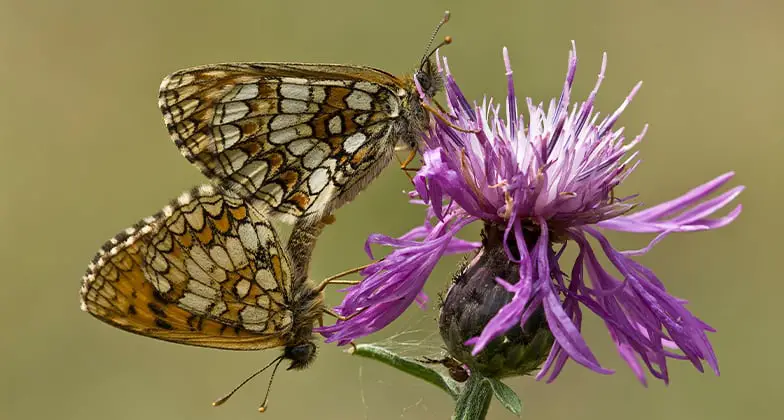
Once the butterflies are together, they will determine if they are a good match by looking at the coloring and behavior of each other. If they like each other, they will mate. Simple as that!
What Butterflies Do Besides Eat: Laying Eggs
After the female and male butterflies have mated, the female will lay her eggs. Female butterflies lay between 100 to 300 eggs at one time. I know that may sound like many eggs, but the chances of these eggs hatching are pretty slim.
Various other creatures in nature like to eat butterfly eggs. The female will lay her eggs under leaves or branches to reduce the chance of them being seen and eaten; however, despite this, a large portion of the eggs will still be devoured.
Conclusion
Butterflies will eat on a daily basis. They use their antennae, feet and proboscis to find and eat their food. Having a constant source of food is necessary for a butterfly to complete other essential life activities such as finding a mate and reproducing.
If you love these little insects as much as I do, take the time to add some beautiful flowers and a butterfly feeder to your garden and watch them fly in from every direction!
Further Reading
All About Butterflies – University of Kentucky College of Agriculture, Food and Environment
The Best Time to See Butterflies Fight? – Chicago Botanic Garden
7 Fascinating Facts About Butterflies – Oregon Live
Driven by a passion for those tiny creatures that rule our world, we at Bug Domain strive to be your go-to resource for information on insects.


